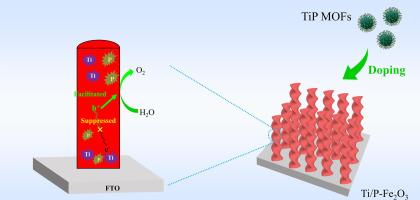A MOF-driven strategy for titanium and phosphorus Co-doping hematite photoanodes to enhance water oxidation
IF 4.7
3区 化学
Q2 CHEMISTRY, PHYSICAL
Journal of Photochemistry and Photobiology A-chemistry
Pub Date : 2025-09-18
DOI:10.1016/j.jphotochem.2025.116790
引用次数: 0
Abstract
Element doping is an effective strategy to boost the photoelectrochemical (PEC) performance of hematite by significantly increasing the carrier density to facilitate charge dynamics. In this study, a Ti and P co-doped hematite photoanode was successfully synthesized using titanium phosphonate metal-organic framework (TiP MOFs) as the precursor. It demonstrates that the synergistic effect of Ti and P co-doping effectively promotes the separation and transport of photogenerated charge carriers both in the bulk and on the surface of the photoanode. Consequently, the resulting photoanode exhibits a remarkably enhanced photocurrent density of 2.84 mA·cm−2 at 1.23 V vs. RHE, approximately 3.3 times higher than the pristine sample. This study provides a promising pathway for the design of element-doped hematite photoanodes with enhanced PEC water oxidation performance.

一种mof驱动的钛磷共掺杂赤铁矿光阳极增强水氧化的策略
元素掺杂是提高赤铁矿光电化学性能的一种有效方法,可以显著提高载流子密度,促进电荷动力学。本研究以磷酸钛金属有机骨架(TiP MOFs)为前驱体,成功合成了Ti和P共掺杂赤铁矿光阳极。结果表明,Ti和P共掺杂的协同效应有效地促进了光阳极本体和表面上光生载流子的分离和输运。结果表明,在1.23 V时,光阳极的光电流密度显著提高,达到2.84 mA·cm - 2,比原始样品高约3.3倍。该研究为设计具有增强PEC水氧化性能的元素掺杂赤铁矿光阳极提供了一条有希望的途径。
本文章由计算机程序翻译,如有差异,请以英文原文为准。
求助全文
约1分钟内获得全文
求助全文
来源期刊
CiteScore
7.90
自引率
7.00%
发文量
580
审稿时长
48 days
期刊介绍:
JPPA publishes the results of fundamental studies on all aspects of chemical phenomena induced by interactions between light and molecules/matter of all kinds.
All systems capable of being described at the molecular or integrated multimolecular level are appropriate for the journal. This includes all molecular chemical species as well as biomolecular, supramolecular, polymer and other macromolecular systems, as well as solid state photochemistry. In addition, the journal publishes studies of semiconductor and other photoactive organic and inorganic materials, photocatalysis (organic, inorganic, supramolecular and superconductor).
The scope includes condensed and gas phase photochemistry, as well as synchrotron radiation chemistry. A broad range of processes and techniques in photochemistry are covered such as light induced energy, electron and proton transfer; nonlinear photochemical behavior; mechanistic investigation of photochemical reactions and identification of the products of photochemical reactions; quantum yield determinations and measurements of rate constants for primary and secondary photochemical processes; steady-state and time-resolved emission, ultrafast spectroscopic methods, single molecule spectroscopy, time resolved X-ray diffraction, luminescence microscopy, and scattering spectroscopy applied to photochemistry. Papers in emerging and applied areas such as luminescent sensors, electroluminescence, solar energy conversion, atmospheric photochemistry, environmental remediation, and related photocatalytic chemistry are also welcome.

 求助内容:
求助内容: 应助结果提醒方式:
应助结果提醒方式:


